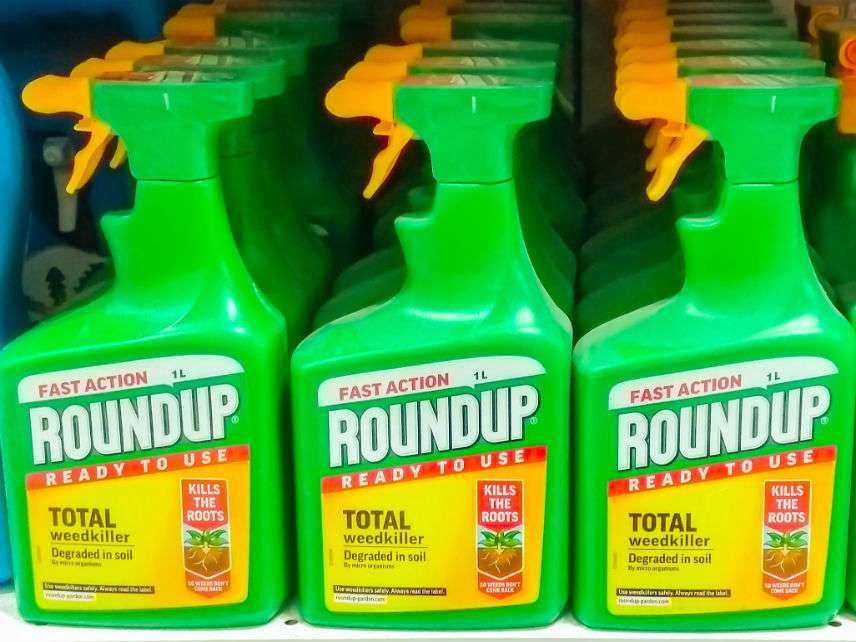A New Study About Roundup and Cancer Doesn't Say What You Probably Think It Does
Is this just another example of epidemiologists torturing the data until they confess to a spurious but headline-grabbing statistical significance?

California school groundskeeper Dewayne Johnson was awarded $286 million in damages last August in his lawsuit alleging that his use of the popular weedkiller glyphosate (sold as Roundup by Monsanto, now a division of A.G. Bayer) had caused him to fall ill with Non-Hodgkin lymphoma (NHL). A judge later cut the award to only $78 million. The company reportedly faces 9,300 other plaintiffs alleging that the herbicide caused their illnesses.
"Glyphosate has a more than 40-year history of safe use. Over those four decades, researchers have conducted more than 800 scientific studies and reviews that support the safe use of glyphosate," asserted a statement from the company after the trial. "The National Institutes of Health (NIH) and the Joint FAO/WHO Meeting on Pesticide Residues (JMPR) both recently reaffirmed glyphosate does not cause cancer. The U.S. Environmental Protection Agency (EPA) and other regulatory authorities in Europe, Canada, Japan, Australia, Korea, and elsewhere routinely review all approved pesticide products and have consistently reaffirmed that glyphosate does not cause cancer."
Who should you believe?
On its face, a new study published last week finding that exposure to glyphosate does increase the risk of non-Hodgkin lymphoma (NHL) in humans by 41 percent seems like a gift to the plaintiffs and their attorneys and a confirmation of their claims. The researchers obtained their result by conducting a meta-analysis of previous studies. This finding stands in contrast with the results of the 2017 Agricultural Health Study (AHS) in the Journal of the National Cancer Institute, which found "no association was apparent between glyphosate and any solid tumors or lymphoid malignancies overall, including NHL and its subtypes." (The AHS has been monitoring the health of thousands of pesticide applicators for a couple of decades now.)
Forty-one percent sounds pretty bad, but let's put in context. About 20 new cases of NHL are diagnosed per 100,000 men and women each year. Assuming that 41 percent figure is right, that would suggest that 8 additional new NHL cases would be expected each year for every 100,000 exposed to glyphosate. Interestingly, the incidence rate of NHL has remained essentially flat even after the advent of herbicide resistant biotech crops encouraged the rising use of glyphosate. Keep in mind that your lifetime risk of developing or dying from cancer if you are male is 40 and 22 percent respectively. If female, the odds are 38 and 19 percent.
Albert Einstein College of Medicine cancer epidemiologist Geoffrey Kabat takes the new study apart and suggests that its findings are badly flawed. The main problem, he argues, is that the researchers combine the results from five case-control studies and one large cohort study which happens to be the one reported in the Journal of the National Cancer Institute cited above. Case-control studies are notoriously susceptible to the effects of bias, which may be introduced as a result of a poor study design or during the collection of exposure and outcome data.
Kabat points out that the authors of the new meta-analysis combined findings from low quality case-control studies with those of the much higher quality AHS cohort study. Kabat then persuasively argues that in order to drag their meta-analytic results over the finish line to statistical significance, the authors of the new study picked only the highest relative risk ratio figure for NHL from the AHS study. If they had chosen any of the other three AHS risk ratios reported for NHL Kabat suggests that their "overall result would likely not have been statistically significant."
"One can't escape the impression that the motivation behind what presents itself as a disinterested academic study was to include a selected and unrepresentative result from the highly-respected AHS in their meta-analysis and use the far inferior case-control studies to jack up the summary relative risk to obtain a statistically-significant finding," concludes Kabat.
Time will tell if this new study is just another example of broken science in which epidemiologists keep torturing the data until they confess to a spurious but headline-grabbing statistical significance.


Show Comments (84)